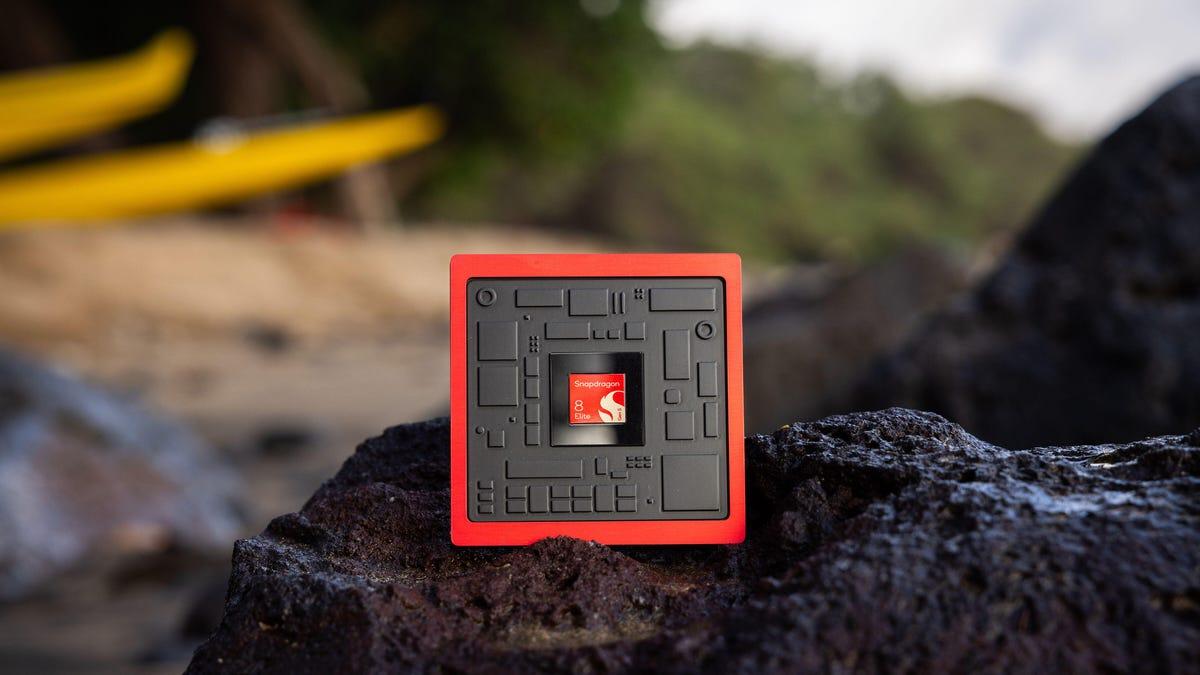Qualcomm's Snapdragon 8 Elite Chipset Introduces AI-Powered Camera Enhancements for Android Phones
2 Sources
2 Sources
[1]
Did Qualcomm just kill the ring light? Future Android phones could let you add a virtual, moveable light source to video calls
Picture the scene: you jump on an important work call, fresh-faced and ready to confidently deliver your trademark "nothing from me" line, only to discover that the light (or lack thereof) in your work-from-home office has left you looking less like a serious businessperson and more like a seedy Omegle user from 2010. Don't worry - we've all been there. Thankfully, Qualcomm knows we've all been there, which is why the American semiconductor giant has seen fit to equip its newly announced Snapdragon 8 Elite mobile chipset with an AI-powered, real-time lighting tool that could banish terrible video call lighting to the annals of internet history. AI Portrait Video Re-lighting lets you add a virtual, moveable light source that maps to the contours of your face to better illuminate it in heavily backlit environments. This lighting can be adjusted manually, or you can let your phone's AI do the work for you, and the entire process takes place on-device, with no added latency. Wait a minute, did Qualcomm just kill the ring light? Qualcomm debuted the new tool at Snapdragon Summit 2024, demonstrating its potential in a nameless dummy phone, though we could conceivably see AI Portrait Video Re-lighting feature (albeit with a different name) in some of the best Android phones of 2025 - think the much rumored Samsung Galaxy S25, OnePlus 13, Xiaomi 15 Ultra, and so on. That's because all of those upcoming flagship phones are expected to be powered by the Snapdragon 8 Elite, meaning their respective OEMs (original equipment manufacturers) will have the option of implementing this new AI technology as they see fit. Indeed, as Qualcomm's Senior Director of Product Management, Judd Heape, confirmed to TechRadar in a roundtable interview at Snapdragon Summit (with reference to Limitless Segmentation, another Snapdragon 8 Elite-specific camera feature): "Limitless Segmentation is embedded into the [Snapdragon 8 Elite] camera framework - it's shipping with the baseline camera. So, it will be up to OEMs as to how they integrate it [and other AI features] into the main products." Limitless Segmentation segments an image into over 250 layers, optimizing and enhancing each layer (including faces, hair, clothing, objects, and backgrounds) in the process, so presumably Qualcomm's AI Portrait Video Re-lighting technology could be applied to still portraits, too. Might we see a "Portraits by Qualcomm" label added to images taken with the best Samsung phones in the near future? It's certainly a possibility. In any case, we're glad to see Qualcomm using the power of its Snapdragon 8 Elite chipset to develop practical generative AI tools like this one. Sure, bespoke emoji creators are great - but they're not going to help you save face when your video call lighting just ain't it.
[2]
4 ways Android cameras are about to get better, thanks to Qualcomm - even for dogs
The chipset in your smartphone does much more than power speed, efficiency, and cool features -- it plays a critical role in the performance of all your phone's functions, including photography. With Qualcomm's latest mobile platform, the Snapdragon 8 Elite, the company aims to enhance how you interact with your camera. Whether you're setting up a video call, snapping a photo, recording a video, or capturing moments with your furry friend, Qualcomm's Snapdragon 8 Elite introduces new, enhanced mobile photography experiences. Also: Qualcomm's new chipset that will power flagship Android phones makes the iPhone seem outdated Since many Android phones utilize Qualcomm's latest mobile platforms, it's likely that many of the new Android phones launching over the next year, including the latest from Samsung, OnePlus, and Motorola, will feature not only this chipset but also some of the enhanced photo-taking capabilities it supports. I had the opportunity to demo most of them at Snapdragon Summit and rounded up the features you can expect, ranked by how helpful I think they will be when they are ready to launch. If you are familiar with Google's Magic Eraser, a feature that allows you to wipe out unwanted subjects in an image with a quick tap, Video Object Eraser is very similar to that for video. Users can swipe out an object and select "delete" to declutter the background or remove the photobomber. Also: How to turn your old Android phone into a security or pet camera One of the biggest advantages is that it happens on device, making the typically cumbersome process quicker and circumventing the cloud, which keeps your video more private. When demoing the feature, I found that it wasn't entirely flushed out yet, but it clearly had promise. Like the feature above, AI Keeper is a photo-editing feature that ensures that what ends up in your shot is exactly what you want. With the feature, you can select the subjects of your photo you want to keep, and then it automatically eliminates everything else. The feature is simple to use, has no frills, and worked well in the demo. If you have a pet, you know it is really difficult to resist the urge to take pictures of their cute faces every day, all day. However, as cute as they are, it can be hard to get a good picture because of how quickly and unpredictably they move. That's where this feature can shine. When your phone is pointed at your pet and the pet looks at the camera, Snapgdragon automatically takes a burst and then picks the best shot. There is also a pet hair enhancement feature to make sure your pet looks its best. Whether you are casually FaceTiming a friend or on a business video call, looking your best on a call matters. However, there are only so many factors you can control, and important variables like lighting are often unpredictable. With Snapdragon 8 Elite's real-time AI Relighting feature, you have more control by adjusting a virtual movable light source and changing the hue. This was another simple feature that worked as simply as described, but it got the intended job done.
Share
Share
Copy Link
Qualcomm's new Snapdragon 8 Elite mobile chipset brings advanced AI-powered camera features to future Android phones, including virtual lighting for video calls and object removal in videos.

Qualcomm Unveils Snapdragon 8 Elite with AI-Powered Camera Features
Qualcomm, the American semiconductor giant, has announced its latest mobile chipset, the Snapdragon 8 Elite, which introduces a suite of AI-powered camera enhancements for future Android smartphones. These innovations aim to revolutionize mobile photography and video calling experiences
1
.AI Portrait Video Re-lighting: A Game-Changer for Video Calls
One of the standout features is AI Portrait Video Re-lighting, which allows users to add a virtual, moveable light source that maps to facial contours. This tool is designed to improve illumination in challenging lighting conditions, potentially eliminating the need for external ring lights. The feature operates on-device without added latency, offering both manual adjustments and AI-driven automatic enhancements
1
.Advanced Image Segmentation and Enhancement
The Snapdragon 8 Elite incorporates Limitless Segmentation, a technology that divides images into over 250 layers. This allows for optimized enhancement of various elements, including faces, hair, clothing, objects, and backgrounds. The feature's integration into the chipset's camera framework suggests potential applications in both video and still photography
1
.Video Object Eraser and AI Keeper
Qualcomm is also introducing Video Object Eraser, a feature similar to Google's Magic Eraser but for video content. Users can remove unwanted objects or declutter backgrounds in videos with a simple swipe and delete action. Additionally, AI Keeper allows users to select and keep specific subjects in a photo while automatically eliminating everything else, offering enhanced control over image composition
2
.Related Stories
Pet-Focused Photography Features
Recognizing the popularity of pet photography, Qualcomm has developed features specifically for capturing images of animals. The chipset can detect when a pet is looking at the camera and automatically take a burst of photos, selecting the best shot. It also includes a pet hair enhancement feature to improve the overall quality of pet portraits
2
.Implications for Future Android Devices
These new features are expected to be available in flagship Android phones launching in 2025, including potential models like the Samsung Galaxy S25, OnePlus 13, and Xiaomi 15 Ultra. However, the implementation of these features will ultimately depend on the original equipment manufacturers (OEMs) and how they choose to integrate them into their products
1
2
.As Qualcomm continues to push the boundaries of mobile photography and video capabilities, these AI-powered features represent a significant step forward in addressing common user pain points and enhancing the overall smartphone camera experience.
References
Summarized by
Navi
Related Stories
Qualcomm's Snapdragon 8 Elite Chip Revolutionizes Pet Photography with AI
23 Oct 2024•Technology

Qualcomm's Snapdragon 8 Elite: Revolutionizing Smartphone Performance and Camera Capabilities
24 Oct 2024•Technology

Qualcomm's Snapdragon 8 Elite Gen 5: Powering Next-Gen Android Phones with Advanced AI and Performance
24 Sept 2025•Technology

Recent Highlights
1
OpenAI releases GPT-5.2 AI model after code red memo targets Google's Gemini 3 threat
Technology

2
Disney invests $1 billion in OpenAI, licenses 200+ characters for Sora video generator
Technology

3
Disney accuses Google of massive copyright infringement through AI-generated character images
Policy and Regulation





